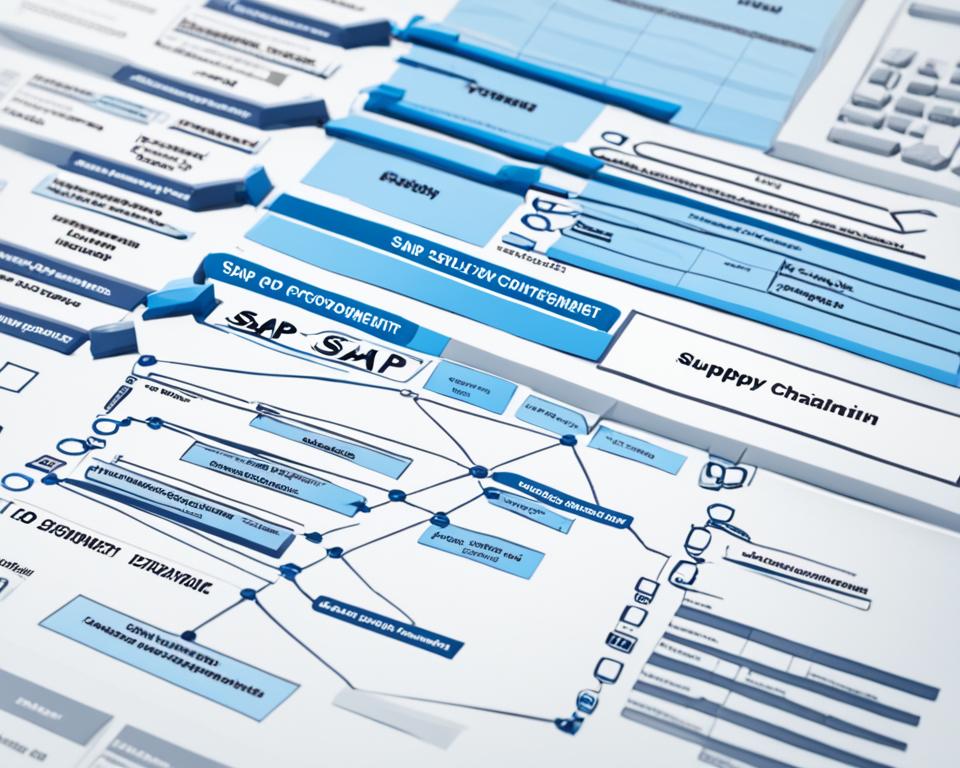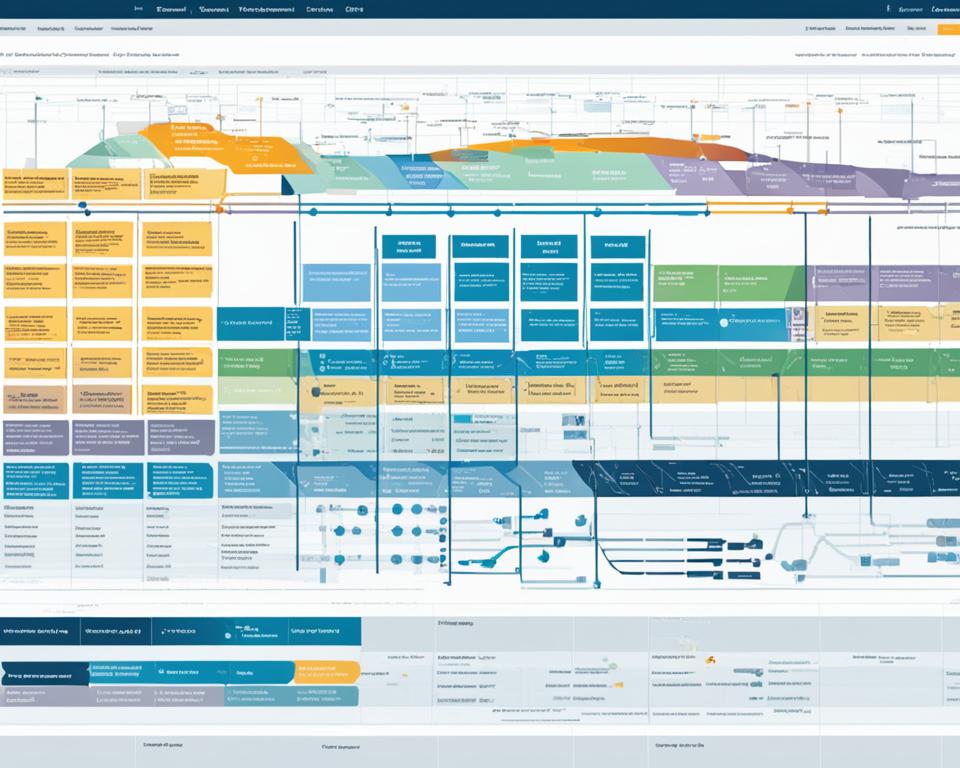Imagine if the success of your supply chain depended on just one tool. SAP Advanced Planning and Optimization (APO) is that tool. It has changed how businesses manage their supply chains. With SAP APO, companies can make their operations more efficient, plan better, and boost profits.
SAP APO brings together production, distribution, and transportation planning. This lets companies use their resources better. It helps with planning and creates a team environment that quickly meets market needs. Let’s explore how SAP APO can change your supply chain for the better.
Key Takeaways
- SAP APO is key for better supply chain management.
- It helps optimize resources in the supply chain.
- The tool combines production and distribution planning.
- Using SAP APO makes operations more efficient.
- Companies can see more profits with SAP APO’s streamlined methods.
- SAP APO encourages teamwork and quick responses to changes in demand.
Understanding SAP APO and Its Importance in Supply Chain Management
In the world of supply chain management, knowing about SAP APO is key for companies wanting to improve their planning. SAP Advanced Planning and Optimization (APO) has strong tools that help businesses predict demand well. This is key for balancing supply and demand, making sure there’s enough stock for customers without having too much.
SAP APO is very important, especially in today’s fast-changing market. Companies deal with constant changes that need quick responses. With SAP APO, companies can make their supply chain planning smoother. This lets them adjust fast to changes in demand or unexpected problems.
From what I’ve seen, using SAP APO makes supply chains more transparent. This means better coordination among different people, leading to smarter decisions. Companies using SAP APO get accurate demand forecasts and can make strategies that make their supply chain work better.
The Components of SAP APO
SAP Advanced Planning and Optimization (APO) has key parts that make supply chains better. These include Demand Planning (DP), Supply Network Planning (SNP), and Production Planning/Detailed Scheduling (PP/DS). Each part is crucial for making logistical processes smoother and helping businesses manage their supply chains well.
Demand Planning (DP) helps predict what customers will buy. It uses past data and analysis to guess future sales. Many companies have seen big improvements in planning thanks to DP. This leads to better stock management and less waste.
Supply Network Planning (SNP) helps create the best supply chain model. It looks at the whole supply network to find problems and fix them. This approach helps different departments work better together, making the supply chain more flexible.
Production Planning/Detailed Scheduling (PP/DS) matches production with demand forecasts. It helps plan production better and reduce idle time. Companies using PP/DS see a smoother flow of products, making their logistics better.

Using these SAP APO parts, companies can greatly improve their supply chains. These tools help them be more agile and responsive to customer needs. This leads to happier customers and more loyalty.
Advancements in Supply Chain Planning with SAP APO
SAP APO keeps getting better, bringing in new tech to improve supply chain planning. It now uses advanced technologies to meet market needs. The latest SAP APO innovations, like real-time data and machine learning, stand out. These features help make better decisions and work more efficiently.
Working with other SAP tools makes things smoother, ensuring data flows well across different areas. This helps companies quickly adapt to new customer wants and needs.
Here’s a table showing how SAP APO changes the game compared to old ways:
| Feature | Traditional Planning | SAP APO Enhanced Planning |
|---|---|---|
| Data Processing Speed | Slow | Real-time |
| Forecast Accuracy | Moderate | High due to machine learning |
| Integration Capability | Limited | Seamless |
| Responsiveness to Market Changes | Slow | Rapid |
These updates in supply chain planning with SAP APO show how tech can give companies an edge. I’m excited to see how these changes will shape the future of supply chain strategies.
Demand Planning with SAP APO
Effective demand planning is key for a strong supply chain. Tools like SAP APO boost accuracy and efficiency. They help businesses make better decisions and streamline processes.
Key Features of Demand Planning
SAP APO has many features for precise demand forecasting. Some top features include:
- Forecast Accuracy: Advanced algorithms use historical trends and market info to improve forecast accuracy.
- Customizable Planning Levels: Users can set different planning levels based on their business needs, making operations more flexible.
- Historical Data Analysis: Analyzing past sales data helps spot patterns and trends, making future demand forecasts more reliable.
Benefits of Effective Demand Planning
Using SAP APO for demand planning brings many benefits. These benefits include:
- Reduced Stockouts: Accurate demand prediction helps avoid stockouts, making sure products are available when needed.
- Improved Customer Satisfaction: Meeting customer demand consistently leads to higher satisfaction and loyalty.
- Optimized Inventory Levels: Good demand planning keeps inventory at the right levels, cutting holding costs and freeing up capital.

Production Planning and SAP APO
Production planning is key to making sure manufacturing meets demand. Using SAP APO makes this planning better. It helps departments work together smoothly. This leads to better responses to market needs.
Integrating Production Planning Efforts
SAP APO helps businesses plan production better. It has tools that help teams work together well. By sharing data in real time, it quickly fixes any supply and demand issues.
This integration brings many benefits. For example:
- Improved collaboration across departments, ensuring sales, production, and inventory are in sync.
- Enhanced visibility into what production can do, leading to smarter decisions.
- Reduced lead time in reacting to demand changes, making manufacturing more flexible.
With SAP APO, planning production schedules gets easier. This leads to less waste and better use of resources. By focusing on data, companies can meet customer needs without spending too much.
Distribution Planning Made Easy with SAP APO
SAP APO is key to better distribution planning. It helps businesses improve their logistics with its strong features. By focusing on better routes and managing inventory well, it boosts supply chain efficiency.
SAP APO distribution optimization shines by analyzing data as it happens. This lets companies make smart choices about how they distribute goods. For example, it uses smart algorithms to find the best delivery routes. This cuts down on transport costs and meets customer needs.
Real companies have changed their distribution plans for the better with SAP APO. They cut down on wait times and avoided running out of stock, making customers happier. Using SAP tools fully is key to keeping up in logistics.
The table below shows the main perks of using SAP APO for distribution planning:
| Benefits | Description |
|---|---|
| Cost Reduction | Efficient route planning cuts down on transport costs. |
| Improved Delivery Times | Using real-time data helps with scheduling and sending out goods. |
| Inventory Optimization | Forecasting accurately lowers excess stock and stockouts. |
| Customer Satisfaction | On-time deliveries increase customer trust and loyalty. |

Choosing advanced solutions like SAP APO keeps companies adaptable and quick to respond to changes. As companies aim for top performance, adding SAP APO to distribution planning is a smart move. It helps them stay ahead in the game.
SAP APO for Transportation Planning
SAP APO is key in transportation planning, helping businesses manage their logistics better. It cuts down on transport costs and makes sure deliveries are on time. With advanced analytics and automation, companies can greatly reduce transport costs.
Optimizing Transportation Costs
Good transportation planning needs smart strategies and data-driven choices. SAP APO gives companies the tools to check routes and shipments on the go. This lets managers:
- Find cheaper routes with up-to-date data.
- Keep track of vehicle capacity to use it better.
- Choose the best carriers based on their performance.
- Use predictive analytics to predict demand spikes.
Challenges in Transportation Planning
Even with SAP APO’s benefits, businesses face hurdles in transportation planning. Fuel price changes can suddenly increase costs. Route problems from weather or traffic add to the challenge. SAP APO helps companies:
- Plan for unexpected issues to reduce their impact.
- Use past data to improve forecasting.
- Combine data from different sources for better insight.
Collaborative Planning Features in SAP APO
The key to great collaborative planning is connecting different people in the supply chain. SAP APO has strong SAP APO collaboration tools for smooth talks between suppliers, retailers, and makers. This lets everyone share data in real time, helping them make smart choices.
Using SAP APO for supply chain collaboration brings better visibility. Everyone can see the same data, so they can quickly adapt to changes. This helps keep inventory in check, cuts down on waste, and makes customers happier.
Also, working together on forecasts and plans means everyone uses the same data. This cuts down on mistakes. It leads to shorter wait times and better coordination in the supply chain. Adding these tools to your work can make things run smoother.
If you’re looking to improve your ABAP skills, check out some tips on making SAP systems run. These can help with planning together in SAP systems.
Implementing SAP APO in Your Business
Implementing SAP APO can change how your supply chain works. I started by learning the key steps to adopt it. First, I looked at our current supply chain to see where we could do better. This step is vital to make SAP APO fit our business needs.
Then, I began the SAP APO onboarding by setting up the system to meet our goals. Having a clear plan helped us stay on track. I made a timeline for each part of the setup. This kept the project moving smoothly and everyone informed.
But, implementing SAP APO wasn’t easy. I faced problems like resistance to change and combining data. These issues showed me how important clear communication and setting realistic goals is. Changing our mindset to accept new ideas helped ease the transition.
Here’s a detailed table on the key steps for SAP APO adoption:
| Step | Description | Action Required |
|---|---|---|
| Step 1 | Assess current supply chain processes | Conduct a detailed analysis of existing workflows |
| Step 2 | Define goals and objectives | Establish clear expectations for SAP APO’s impact |
| Step 3 | Configure SAP APO to align with business needs | Customize the system features based on the analyses |
| Step 4 | Conduct training and support for staff | Provide comprehensive education on SAP APO functionalities |
| Step 5 | Monitor and evaluate performance | Regularly assess the outcomes of the implementation |
Getting SAP APO up and running needs a solid plan. My experience shows how crucial preparation, good communication, and support are. For those looking to make SAP development easier, checking out ABAP Web Dynpro resources can help. You can learn more about this here.
Benefits of Utilizing SAP APO for Your Supply Chain Needs
Businesses that want to improve their operations find many benefits in using SAP Advanced Planning and Optimization (APO). This tool boosts efficiency and productivity. It also helps with making decisions based on data. By understanding these points, companies see how SAP APO changes supply chain management.
Increased Efficiency and Productivity
Using SAP APO makes processes smoother, improving supply chain efficiency. It automates planning, cutting down on manual mistakes and data entry time. Key features that help with productivity are:
- Real-time data sharing across departments
- Automated forecasting models that adapt to trends
- Optimized inventory management
These features let teams work on big projects instead of daily tasks. This boosts output and meets goals.
Data-Driven Decision Making
SAP APO is great for making decisions based on data. It gives deep insights into how the supply chain is doing. This lets companies act on facts, not guesses. They can look at:
- Historical sales data to predict future demand
- Supplier performance metrics to identify reliability
- Market trends to adjust strategies
Using this data helps executives and managers make smart choices. These choices can greatly improve supply chain strength.

SAP APO: Advanced Planning and Optimization
The world of supply chain management needs strong solutions. SAP APO advanced planning offers key features that boost efficiency. It uses optimization techniques to help businesses make smart decisions for better supply chain management. Advanced analytics give a deep look into data patterns and trends, guiding strategic planning.
Scenario planning is a big part of SAP APO. It lets companies see different outcomes under different conditions. This helps them get ready for surprises. Plus, combining these techniques makes the supply chain more agile and quick to respond.
With these advanced tools, businesses can stay ahead in a fast market. SAP APO gives insights for better resource use, inventory, and forecasting demand. For more on how to improve procurement and supplier relations, check out the SAP Ariba Modules overview.
Using SAP APO for advanced planning makes operations smoother. It helps with a wider strategy for improving the supply chain. Companies that invest in these technologies can handle complex challenges and grow sustainably.
Real-World Success Stories Using SAP APO
Companies that use SAP APO have seen big improvements in their supply chains. These SAP APO success stories show how powerful this platform is. For example, a big manufacturer cut its forecasting mistakes by 30% with SAP APO. This proves the power of using up-to-date data for better predictions.
A global retailer also made its operations smoother with SAP APO. They boosted their inventory turnover by 25%. This led to big cost cuts and happier customers. These results are strong proof of SAP APO’s benefits.
The table below shows more success stories from different companies:
| Company | Industry | Benefits Achieved |
|---|---|---|
| Leading Manufacturer | Consumer Goods | 30% reduction in forecasting errors |
| Global Retailer | Retail | 25% improvement in inventory turnover |
| Pharmaceutical Company | Healthcare | 15% lower operational costs |
| Automotive Supplier | Automotive | 20% increase in on-time deliveries |
Looking into how SAP APO works with other systems can also boost supply chain performance. These stories show that using SAP APO leads to better processes and a stronger competitive edge.

Tips for Maximizing the Value of SAP APO
To get the most out of SAP APO, you need a smart plan. Using SAP APO best practices is key to improving supply chain efficiency. Here are some important tips to help your business use SAP APO well:
- Invest in Regular Training: Keeping staff up to speed with SAP APO through ongoing training is crucial. This ensures they can use the software fully, leading to smarter decisions.
- Conduct Continuous Data Evaluation: Checking data often keeps it accurate and up-to-date. By spotting trends and patterns, companies can tweak their strategies for better results.
- Adapt to Changing Market Conditions: The supply chain is always changing, so being quick to adapt is vital. SAP APO’s tools help businesses stay ahead by responding fast to market shifts.
- Foster Collaboration: SAP APO’s collaborative features make teamwork easier. Working together can make operations smoother and quicker.
- Utilize Advanced Analytics: SAP APO’s advanced analytics give deep insights into how things are going. Using this data helps fine-tune strategies and increase efficiency.
The Future of Supply Chain Management and SAP APO
The world of supply chain management is changing fast. The future will focus on new technology and fresh ways of doing things. SAP APO is key in this change, adapting to new trends and challenges. With advances in artificial intelligence and machine learning, SAP APO is moving toward smarter supply chain solutions. These solutions will make things more efficient and accurate.
New tools for data analytics will soon be available. They will give businesses insights into what customers want, how demand changes, and how to manage stock better. This will help companies make smart choices with real-time data. It’s clear that using these technologies will be crucial for staying competitive in the future.
Another big step is the integration of collaborative planning tools in SAP APO. These tools will help everyone involved talk better, leading to smoother operations. Companies that adopt these changes will likely see big improvements in how they work and their overall success.
Here’s a detailed look at what’s shaping the future of supply chain management:
| Innovation | Description | Impact on Supply Chain Management |
|---|---|---|
| AI and Machine Learning | Automation of routine tasks, predictive analytics for demand forecasting. | Enhanced decision-making, improved responsiveness to market changes. |
| Data-Driven Strategies | Leveraging big data to analyze trends and consumer preferences. | Increased accuracy in planning and inventory control, reduced waste. |
| Collaborative Networks | Integration of communication tools across supply chain partners. | Improved coordination, reduced lead times, greater agility. |
The future of supply chain management highlights the need for tools like SAP APO. By using these new technologies, companies can tackle challenges better. This will help them optimize their supply chains for success in a fast-changing market.
Conclusion
Looking back, SAP APO has changed how we manage supply chains. It offers tools like demand planning and production planning. These tools help businesses work better and meet market needs.
SAP APO does more than just make things run smoother. It helps companies make decisions based on data. This can lead to long-term success. Companies using SAP APO can handle today’s complex supply chains and grow for the future.
The future looks bright for SAP APO as technology gets better. Companies should think about adding SAP APO to their plans. It’s not just software; it’s key to being great at supply chain management. I think using SAP APO will help businesses face new challenges well. This will keep them successful in a changing market.
FAQ
What is SAP APO and why is it important for supply chain management?
SAP Advanced Planning and Optimization (APO) is a key tool for better supply chain management. It helps with demand planning, production, distribution, and transportation planning. It’s vital because it makes resource use better, improves forecasting, and connects logistical processes. This leads to more efficiency and profits for companies.
How does SAP APO assist with demand planning?
SAP APO helps businesses predict future demand by using past data and market trends. It has customizable planning levels and advanced analytics. This helps keep supply and demand in balance, reducing stockouts and making customers happier.
What are the main components of SAP APO?
SAP APO has three main parts: Demand Planning (DP), Supply Network Planning (SNP), and Production Planning/Detailed Scheduling (PP/DS). Each part is crucial for optimizing supply chain aspects like forecasting and scheduling. This ensures smoother logistical processes and better inventory management.
Can you explain the advancements in SAP APO?
SAP APO has seen big improvements, like real-time data processing and better integration with SAP modules. It now uses machine learning too. These updates help companies adapt to market changes, making their supply chain planning and operations more agile.
How does SAP APO optimize transportation planning?
SAP APO has tools for solving transportation planning issues, like finding the best routes and managing costs. It helps businesses analyze logistics to cut costs and meet customer expectations, even with things like changing fuel prices and route problems.
What benefits can businesses realize by implementing SAP APO?
SAP APO brings more efficiency and productivity, better data-driven decisions, lower costs, and happier customers. Its analytics help companies make smart choices with real-time data, leading to a better supply chain.
What are the best practices for maximizing the value of SAP APO?
To get the most from SAP APO, keep staff updated on new features, check data regularly for accuracy, and adjust plans for market changes. Working together with team members also boosts supply chain efficiency.


